For the 3 types of target markets you can go after, jump to here.
For the skills and boundaries checklist, go here.
–
Most states don’t require licenses for recovery coaching. You can start helping people today.
72.2% of adults who struggled with substance use consider themselves in recovery, but only 23.6% who need treatment actually receive it. Source: Substance Abuse and Mental Health Services Administration.
There are over 17,000 substance abuse treatment facilities in the US (Source). Each one treats hundreds of people annually.
But here’s what nobody talks about: what happens when someone leaves treatment? Who helps them navigate that first job interview sober? Who do they call when their old drinking buddies show up at their door?
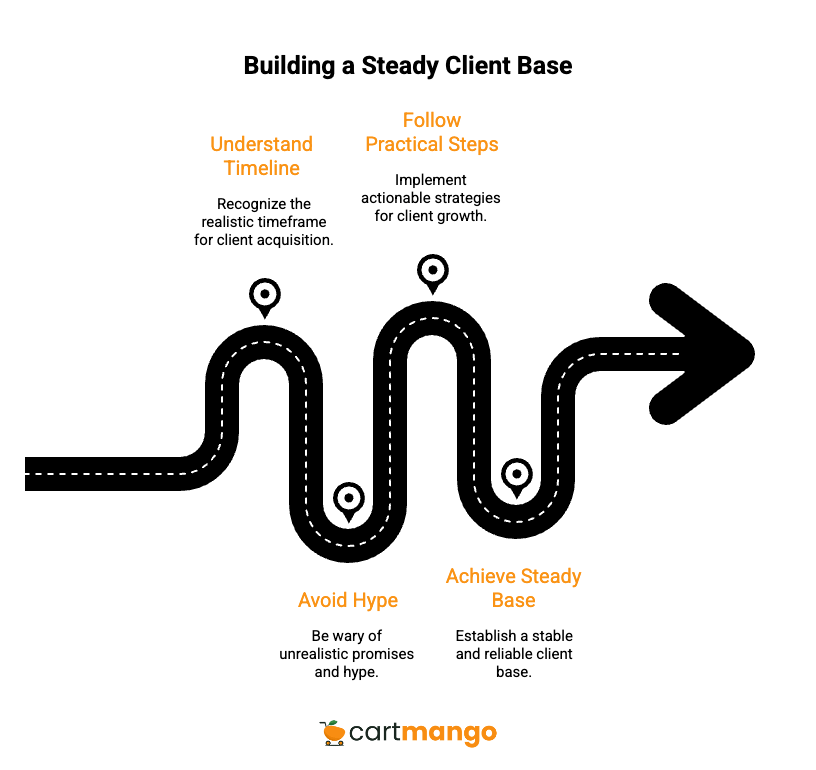
I’m going to be straight with you about the timeline. Building a steady client base takes 6-12+ months. Anyone promising you’ll have paying clients in 30 days is selling you something. This guide gives you practical steps without the usual hype.
Realistic Income Timeline
Let me break down what you can actually earn as a sobriety coach. I’ve seen too many people quit their day jobs thinking they’ll make six figures in year one. That’s not reality.
Year 1: You’ll likely earn $3,000-6,000 monthly with 5-8 regular clients.
Year 2: Your income can grow to $6,000-12,000 monthly with an established base of 10-15 clients.
Based on ZipRecruiter, hourly rates break down like this:
- Beginners: $50-75/hour
- Established coaches: $100-150/hour
- Specialized coaches: $200+/hour
Your full-time potential reaches $75,000-150,000 annually for established practices. But here’s the part that might make your stomach drop: building sustainable income requires consistent effort over 12-24+ months.
When most people saw these numbers, their hands were shaking with excitement. Then reality hit. You’ll invest 15-25 hours weekly initially, growing to 25-35 hours when established.
Half that time goes to actual coaching.
The other half? Business development, networking, and all the unsexy stuff nobody mentions.
Must-Have Skills and Boundaries
Core Competencies You Need
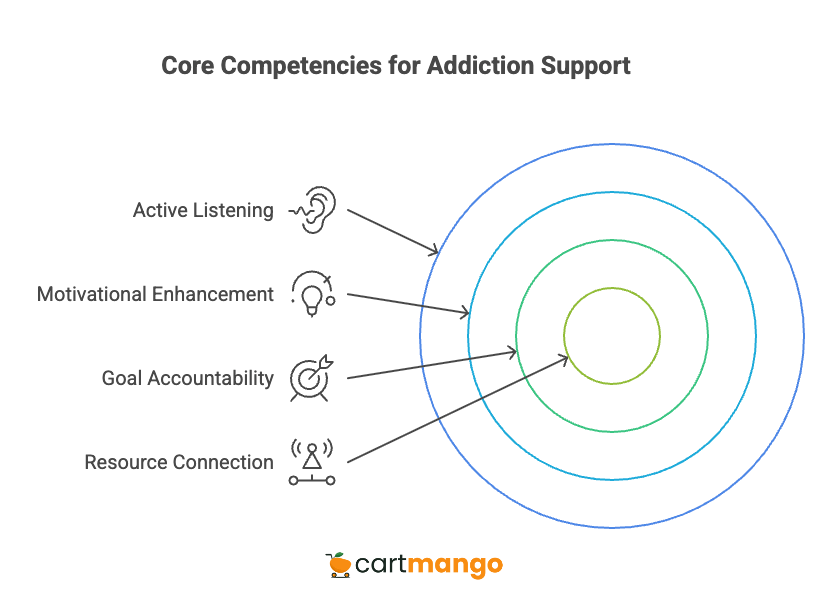
Active listening means reflecting back what clients say without adding your own spin. You’re not fixing them. You’re not solving their problems. You’re helping them find their own answers.
Motivational enhancement helps people discover their own reasons for staying sober. MHTTC training resources teach these techniques. The magic happens when someone realizes they want to change, not when you tell them they should.
Goal accountability involves weekly check-ins with small, achievable targets using SMART goal frameworks. Think “I’ll attend three AA meetings this week” instead of “I’ll get my life together.”
Resource connection means knowing local AA/NA meetings, alternative support groups, crisis numbers, and professional referrals by heart.
–
Legal Boundaries (CRITICAL)
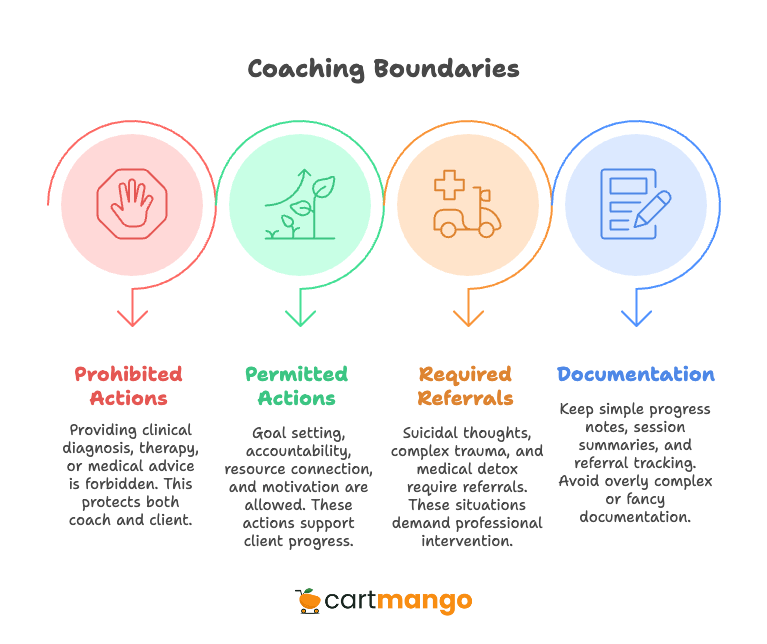
You cannot provide clinical diagnosis, therapy sessions, medical advice, crisis counseling, or treatment planning. Period. Following professional boundary guidelines keeps you and your clients safe.
What you can do: goal setting, accountability support, resource connection, and motivation coaching. When someone mentions suicidal thoughts, you refer immediately. Complex trauma? Refer. Medical detox needs? Refer.
I’ve seen coaches destroy their practices by overstepping these boundaries. Don’t be that person sitting across from a lawyer explaining why you thought you could handle your client’s panic attacks. Keep simple progress notes, session summaries, and referral tracking. Nothing fancy.
–
Skills & Boundaries Checklist
Use this after each practice session:
Active Listening Demonstrated
- Reflected back what client said without adding interpretation
- Asked open-ended questions rather than yes/no questions
- Avoided giving advice or telling them what to do
Motivational Interviewing Applied
- Helped client identify their own reasons for change
- Explored client’s values and goals rather than imposing mine
- Rolled with resistance instead of arguing
Appropriate Boundaries Maintained
- Stayed within coaching scope, avoided therapy topics
- Referred appropriately when issues were beyond expertise
- Maintained professional relationship, avoided becoming “friend”
Goal Accountability Provided
- Helped client set specific, achievable short-term goals
- Reviewed progress from previous session
- Planned concrete action steps for coming week
Crisis Assessment Completed
- Asked about suicidal thoughts when appropriate
- Identified immediate safety concerns
- Made referrals to crisis resources when necessary
Progress Documented
- Recorded session summary and client progress
- Noted any referrals made
- Planned focus areas for next session
Target Markets (Choose 1 Focus Initially)
Market Segment | Age Range | How to Reach Them | Session Style | Pricing Range | Unique Challenges | Best If You Have |
|---|---|---|---|---|---|---|
Young Adults | 18-30 | Instagram, TikTok, college recovery programs | Flexible scheduling, text check-ins | $50-65/hour | Career planning, peer pressure, family dynamics | Social media skills, understanding college pressures |
Working Professionals | 30-50 | LinkedIn, employee assistance programs | Evening/lunch calls, confidential approach | $75-125/hour | Career protection, work stress, time constraints | Business background, professional network |
Family Members | All ages | Family therapy referrals, Al-Anon connections | Spouse coaching, parent support | $100-150/hour | Codependency, boundary setting, trust rebuilding | Personal experience with family addiction |
Pick one initially. Trying to serve everyone means helping no one well.
Consider your background carefully. Which group can you authentically connect with? Assess local demand by researching which recovery resources are lacking in your area.
Start where you have connections. Existing relationships make client acquisition infinitely easier than cold outreach to strangers.
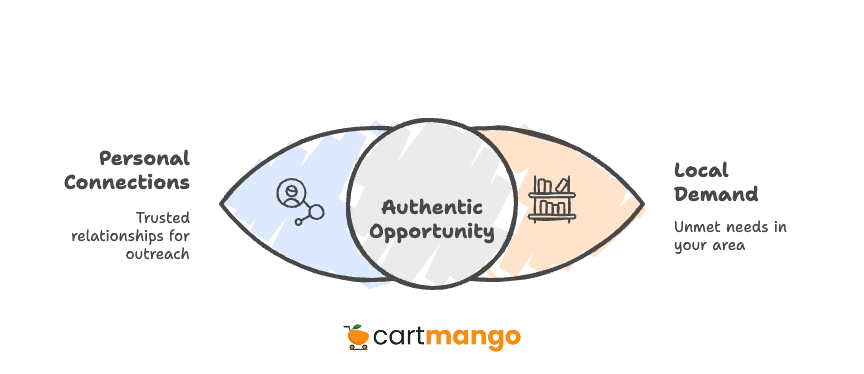
Month 1: Foundation Building
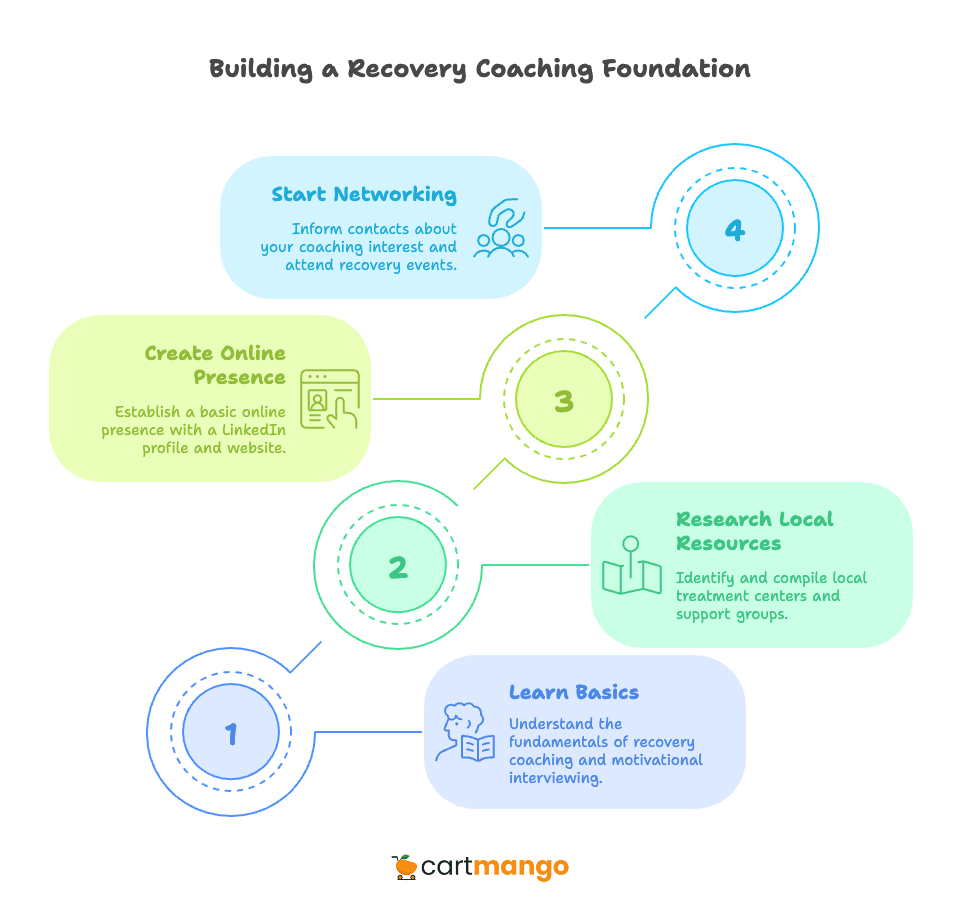
Week 1-2: Learn the Basics
Understand what recovery coaching actually involves. It’s different from therapy, counseling, and peer support in specific ways. Study motivational interviewing through free online resources and YouTube videos. Practice the exercises until they feel natural.
Research your local area thoroughly. Find treatment centers, therapists, support groups, and crisis resources. Create a basic online presence with a LinkedIn profile and simple website using SEO best practices. Your goal is building foundational knowledge, not expecting clients yet.
Your first two weeks will be overwhelmed by all the information. The key is starting somewhere, anywhere, rather than trying to absorb everything perfectly.
Week 3-4: Start Networking
Tell everyone you know about your coaching interest. Friends, family, professional contacts. Be specific about what you’re doing and who you want to help.
Attend recovery events like open AA/NA meetings, recovery conferences, and networking events. Begin building relationships with local treatment providers and therapists. Your expectation should be building awareness and relationships, nothing more.
Most people won’t respond immediately. That’s normal. Relationship building in healthcare moves slowly because trust matters more than speed.
Months 2-3: Building Credibility
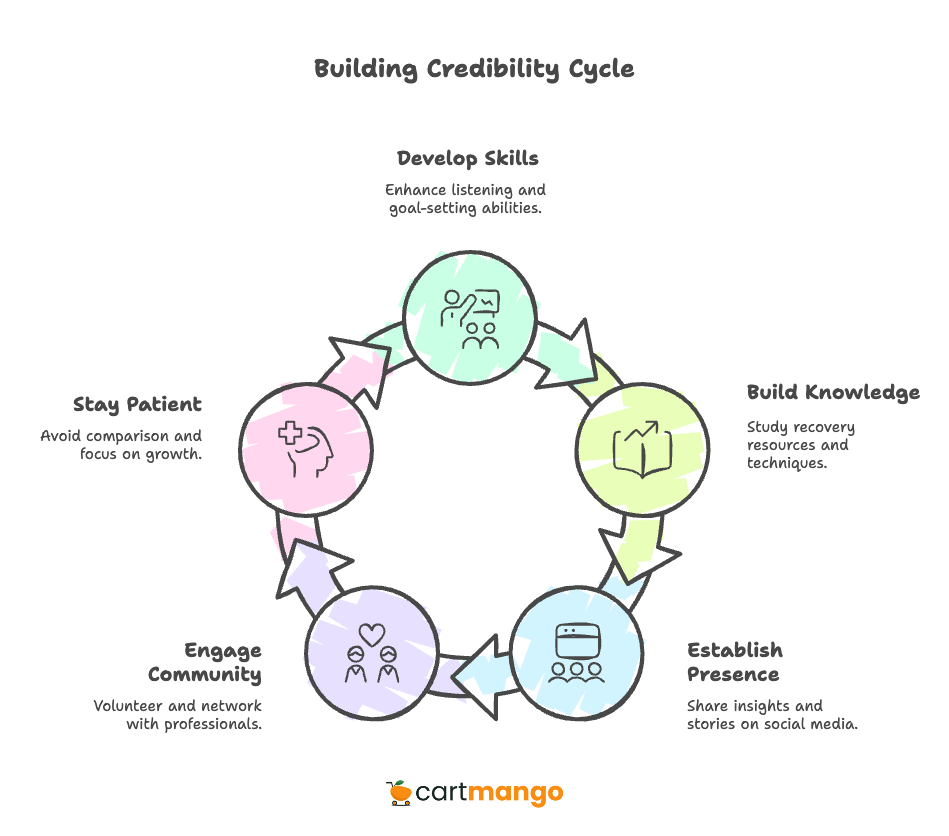
Skill Development Focus
- Practice listening skills through role-play with friends and family members.
- Learn goal-setting frameworks including SMART goals, accountability systems, and progress tracking methods.
- Study common challenges like relapse prevention, trigger management, and motivation maintenance.
Build your knowledge base by reading recovery books and following reputable recovery blogs and podcasts. Here’s a good resource on Motivational Interviewing.
Build a Professional Presence
Your social media strategy should share helpful recovery tips, motivational content, and resource information. Personal stories about your own struggles and how you overcame them work incredibly well.
Community involvement means volunteering at recovery events, support group meetings, and treatment centers. Network building involves connecting with therapists, counselors, treatment center staff, and medical professionals. Your goal is building a reputation as knowledgeable, trustworthy, and genuinely helpful.
Perhaps the hardest part of this phase is staying patient. You’ll watch other coaches on social media posting about their success stories while you’re still practicing basic conversation skills with your neighbor. That comparison will eat you alive if you let it.
Months 4-6: First Client Attempts
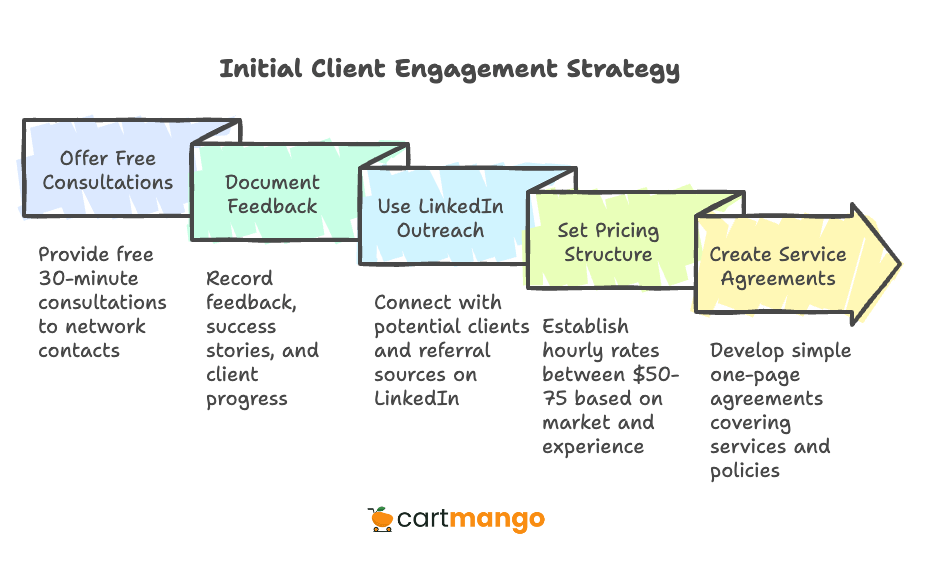
Offer Practice Services
Start with free 30-minute consultations for people in your network who might benefit. Help friends or acquaintances with goal accountability and support as volunteer coaching. Document feedback, success stories, and client progress with written permission for testimonials.
Use LinkedIn outreach to connect with potential clients and referral sources. Your realistic expectation is that most initial “clients” will be people you already know personally. That’s perfectly fine.
Free work feels wrong when you need income. I get it. But testimonials from real people matter more than premature paid sessions with strangers who don’t trust you yet.
Simple Business Setup
Set your pricing structure at around $50-75/hour starting range based on your target market and experience level. Keep payment methods simple with cash, Venmo, PayPal, or basic Square setup. You can use the free version of Calendly to set up appointments.
Create simple one-page service agreements covering services, rates, and cancellation policies. Nothing fancy. You need protection without scaring away clients with legal jargon.
Months 7-12: Growing Your Practice
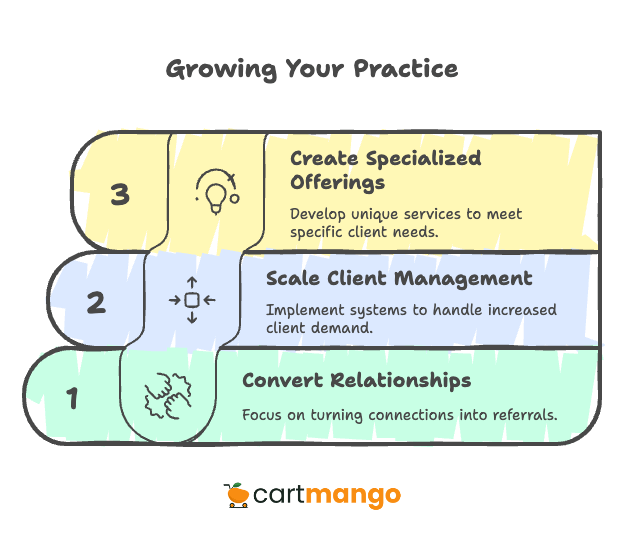
Converting Relationships into Paying Referrals
By now you’ve built relationships with treatment providers and attended networking events. This phase focuses on converting those connections into actual referrals. Follow up with every contact you made in months 1-6 with a brief update on your practice and availability.
Create a simple referral tracking system to monitor which sources send you clients. Send thank-you notes to referral sources within 48 hours of receiving new clients. Offer to provide progress updates to referring professionals (with client permission) to build trust.
Scaling Your Client Management
With 5-8 regular clients, you need systems for managing increased demand. Ask questions that screen for good-fit clients versus those needing clinical treatment. Create waiting lists for popular time slots rather than overcommitting yourself.
Establish clear boundaries around availability and emergency contact. Consider offering different service levels like weekly sessions ($75/hour), bi-weekly check-ins ($65/hour), or monthly maintenance sessions ($85/hour). Package deals like “90-Day Recovery Support Program” ($1,200 total) create predictable income.
Creating Specialized Offerings
Use client feedback to identify gaps in your local market. Maybe working professionals need lunch-hour sessions. Perhaps family members want group coaching sessions. Young adults might prefer text-based accountability between sessions.
Test one specialized offering at a time. Track which services generate the most demand and highest client satisfaction. Your goal is building a practice that serves clients better while increasing your income beyond basic hourly rates.
Tools
Start Simple and Free
Use Zoom free, Google Meet, or simple phone calls for video calling. Keep client notes in your phone notepad app, simple notebook, or basic Google Docs.
Use Stripe and/or PayPal to take payments. Pair them with a tool like CartMango (free for at least 2025) and you’ll unleash revenue-boosting capabilities.
Upgrade Gradually (After 6+ Clients)
Professional video platforms like Zoom Basic cost $14.99 monthly when you have steady income. Advanced scheduling through paid Calendly or Acuity Scheduling improves client experience. Simple spreadsheets, Airtable, or basic CRM systems help with progress tracking.
HIPAA considerations include secure email, encrypted file storage, and professional communication platforms. Don’t overthink this initially, but plan for compliance as you grow.
Common Mistakes and How to Avoid Them
Mistake Category | Specific Mistake | Why It Happens | Solution |
|---|---|---|---|
Unrealistic Expectations | Expecting clients within 30 days | Overoptimistic marketing promises | Set 6-12 month timeline, focus on relationship building |
Quitting day job immediately | Excitement about new career | Start part-time, maintain steady income for 12-24 months | |
Underestimating time investment | Focus only on client sessions | Schedule 50% client work, 50% marketing/networking | |
Thinking certification equals clients | Belief credentials automatically bring business | Invest in networking before expensive certifications | |
Professional Boundaries | Providing therapy without license | Clients ask for help beyond scope | Refer immediately: “That sounds like something for your therapist” |
Being available 24/7 | Wanting to help, fear of losing clients | Set clear hours: “I’m available Mon-Fri 9-5, crisis line after hours” | |
Becoming friends with clients | Natural human connection | Keep personal life separate, maintain professional focus | |
Poor documentation | Informal approach, time constraints | 5-minute post-session notes, simple progress tracking | |
Business Setup | Pricing below $50/hour | Lack of confidence, fear of rejection | Start at $50/hour minimum, research market rates |
No written agreements | Avoiding “business” feel | Use one-page agreement covering basics | |
Poor financial tracking | Dislike of paperwork | Simple spreadsheet: income, expenses, mileage | |
Mixing personal and business | Convenience, cost-saving mentality | Separate business phone, email, bank account |
Quick Reference Guide:
- Do: Set realistic 6-12 month timelines, maintain boundaries, document everything, price appropriately ($50+ minimum)
- Don’t: Expect quick clients, provide therapy, be available 24/7, work for less than $50/hour
- Red Flags: Client asks for therapy, wants to be friends, expects immediate results, refuses fair rates
Understanding Your Training Options
Now that you know what pitfalls to avoid, let’s talk about getting the foundation you actually need. Sobriety and recovery coach training can be overwhelming. There are so many options, each promising to make you a successful sober coach overnight.
Some addiction professionals swear by in person programs where you can practice with real people. Others choose self paced online training that lets you learn between your current job and family obligations.
The course curriculum varies wildly between providers. Some focus heavily on the recovery process and addiction recovery basics. Others dive deep into crisis intervention techniques that might leave you feeling like you’re drowning in scenarios you hope you’ll never face.
The international association standards help separate legitimate coach training from expensive fluff. Course content should cover practical skills, not just theory that sounds good on paper. New sober coaches need real guidance, not another certificate to hang on the wall.
Online training works for people juggling multiple responsibilities. Many folks join facebook groups with other students, and those late-night discussions can teach you more than some of the formal modules. The peer support during your learning journey matters more than you’d expect.
Coach certification from reputable programs gives you credibility in the addiction recovery field. But here’s what nobody tells you: the key differences between programs aren’t always obvious until you’re halfway through. Research thoroughly before you hand over your credit card.
Building Something That Actually Works
Your path to becoming a successful career coach starts with understanding the job market reality. The addiction recovery field needs more qualified people, but not everyone who starts will make it. That’s just honest truth.
You might help someone maintain sobriety through weekly calls. Or support them as they overcome obstacles that would have triggered a relapse six months ago.
The coaching relationship you build becomes everything. Some clients need you to be their sober companion for specific events. Others want someone to check in weekly and celebrate small wins that nobody else understands.
Your role differs from traditional addiction counseling approaches. You’re not their addiction counselor, and that boundary trips up a lot of new people. You offer support through shared understanding, not clinical treatment. This creates different healing options for people navigating their own journey toward long term sobriety.
Building a strong online presence feels awkward when you’re starting out. But potential clients search for help at 4 AM when they can’t sleep. Your website might be the first thing someone finds when they’re ready to take their recovery seriously.
The Reality of Supporting Others
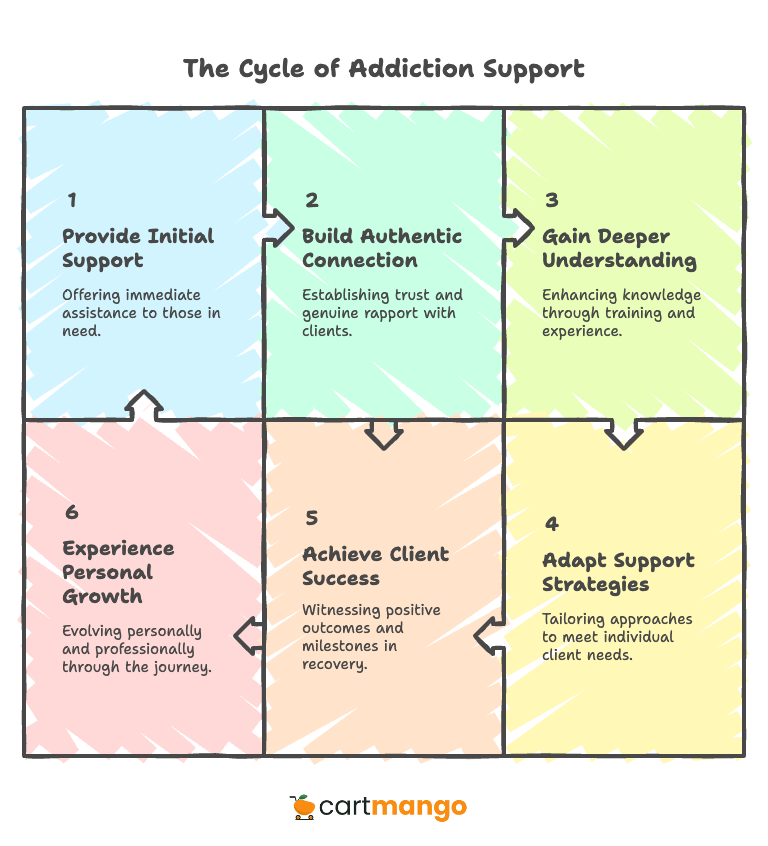
This fulfilling career comes with weight you don’t expect. When someone calls you crying because they almost relapsed at their sister’s wedding, you realize the vital role you play in their journey. It’s not just a job anymore.
Your own journey influences everything about how you offer support. People struggling with addiction can sense authenticity from a mile away. They’ve heard enough fake promises and surface-level encouragement to last a lifetime.
The deeper understanding you gain through training and real experience prepares you for moments that textbooks never cover. Crisis intervention skills matter, but so does knowing when someone just needs you to listen while they figure things out themselves.
People need different types of ongoing support at various stages. Your coaching practice adapts as you learn what actually helps versus what sounds helpful. Some clients want weekly structure. Others need you available for occasional reality checks.
Long term recovery isn’t a straight line, and neither is building a successful practice around supporting it. But when you help someone maintain sobriety through their first year, or watch them overcome obstacles that used to define their entire existence, you understand why this work matters.
Financial freedom becomes possible as you develop expertise that people actually value. The personal development you gain through supporting others changes you in ways you can’t anticipate. It’s messy, challenging, and meaningful in every way.
Your Turn to Become A Sobriety Coach
Follow the tips I shared above. Actually do it even when it’s tough. And it will get though.
The hardest part about this isn’t the tasks themselves. It’s maintaining momentum when nothing seems to happen quickly. You’ll research treatment centers and hear nothing back. You’ll practice motivational interviewing with your spouse and feel ridiculous. You’ll attend networking events where everyone seems more qualified than you.
Keep going anyway. Every expert was once a beginner who felt completely lost. The difference between those who succeed and those who quit is simply continuing to show up when everything feels pointless.
Your future clients are out there right now, probably scrolling through their phones at midnight, looking for someone who understands their struggle. They need what you’re going to offer. They just don’t know it yet.
Related
- Sellfy vs Payhip: The Recurring Revenue Prison (2026)
- Podia vs Gumroad: The Recurring Revenue Handcuffs (2026)
- SendOwl vs Gumroad: The Recurring Revenue Black Hole (2026)
- Gumroad vs Sellfy: The Vendor Lock-in Cage (2025)
- Gumroad vs Payhip: The Hidden Trap for Creators (2025)
- ThriveCart vs SamCart – The Subscription Hostage Trap (2025)
- 8 ThriveCart Alternatives & The Lifetime Pricing Paradox (2025)
- 8 SamCart alternatives + Subscription hostage (2025)
- The GENTLE Method: Soft marketing for creators
- How Far in Advance Should You Promote a Webinar?
